This blog was written before Pardot was renamed to Marketing Cloud Account Engagement. You can read more about the name change and what it means here.
Pardot dynamic lists are an extremely useful automation tool that all Pardot users need to take advantage of.
In short, they automatically segment your prospects, based on matching a set of rule-based criteria.
Thanks to their segmentation capabilities and admin efficiency, they can be used as a recipient list or a suppression list for emails and engagement studio programs. They can even be set up quickly for reporting purposes!
For example, we’d use a dynamic list if we require a list of prospects whose last engagement was greater than 100 days ago to enter a specific engagement studio nurturing program.
Why?
Well, after defining the rule criteria once, the dynamic list will continuously use that rule to add prospects from the list. If they no longer meet that criteria, they will be removed from the list automatically.

Note: Once created, dynamic lists can take around 15 minutes to update with prospects.
What is a dynamic list?
Dynamic lists refresh continuously in the background, checking which prospects now match a set criteria and removing prospects who no longer do.
As prospect behaviour and data determines whether a person matches the criteria, their membership can change at any given moment.
In the case of wanting to send an email to remind prospects that their subscription needs to be renewed within two weeks, you can use a dynamic list. The list will automatically match the correct prospects to receive the content.
Once we’ve set up the predefined rules, a dynamic list will essentially organise our prospects for us and automate our marketing actions saving valuable time and providing endless opportunities to advance our activity.
How to segment your prospects with Dynamic List Rule criteria
The Pardot dynamic list rule builder interface is laid out similar to other Pardot automation tools - making it super easy to configure and add multiple criterias.
Firstly, select the match type; in order for the prospect to be a member of the list, will they have to meet all the rule-based criteria, or at least one rule?
Secondly, use the dropdown to select the rule criteria. Whether the prospects match this is essentially what pulls them into the dynamic list.
For example, say we’re using a dynamic list as a recipient list to send a monthly newsletter email to prospects with the tag newsletter subscriber’.
Any prospects who do not have the tag on their profile will not be a member of the dynamic list and therefore not receive the email.
The key factor to remember, when using dynamic lists, is you cannot manually add or remove prospects.
The list refreshes at regular intervals, looking for prospects who match and removing prospects who don’t.
As these lists cannot be managed manually, they are not an option in dropdowns on imports and are not an option in the dropdown on prospect tables.
Using a Pardot Dynamic List as a Public List
When creating a list, if we choose to tick the textbox Public List’ the dynamic list will be displayed in the email preference center. Meaning, only when prospects meet the list criteria will they be able to see the list.
This is a huge feature and means you can show specific lists to specific people.
Maybe you have VIP events that you only want the biggest companies to be able to opt-in to, this would be a great use case for this feature.

However, if you want all prospects to have the option to opt in to a specific list from the Email preference page, don’t make it a dynamic list. Unless they match the criteria, they won’t be able to see the list.
How to create a Dynamic Suppression List
One simple automation solution to avoid oversaturating prospects with emails or engagement studio nurture emails, is to implement a dynamic suppression list!
Simply create a dynamic list, as normal, with a rule type that filters prospects based on the recency and frequency of email sends, like so:

This will ensure any prospect who has been emailed twice in the last 7 days will not receive further engagement as they will be added to this list.
Once the 7 days are up, they will be removed from this suppression list and may receive emails. However, if they receive two emails within 4 days for example, they will be added back to this list.
Important to note, this rule will only consider list emails and emails sent from Engagement Studio programs!
What happens when we split a Dynamic List?
Dynamic lists simplify our marketing efforts and make Pardot more efficient. They maintain themselves and are ideal for frequently changing data, but it’s important to remember not every list needs to be a dynamic list.
Sometimes, we may just need a list where prospects are on the list - for good. For example, if we required a list of prospects who have downloaded a specific white paper from our website.
Ever created a dynamic list and hundreds of prospects match? One solution to this: split the list!
Splitting a dynamic list creates static lists. Once a split has occurred, a prospect who was on the dynamic list will not automatically be added to the split lists via the rule criteria.
Although you do have the option to choose if the original dynamic list prospects will be evenly distributed to the list, or by a specific distribution percentage, we’re unable to decide who is on which list. This will be done randomly within Pardot.
Additionally, these new static lists will be living alongside the original dynamic list - but cannot revert back to a dynamic list again.
What needs to be considered before creating Dynamic Lists?
Before we jump in feet first and start creating new Pardot dynamic lists, it’s important to consider which lists benefit from being dynamic.
Key points we recommend to clients are:
- Using dynamic lists for scheduled emails means the email will only be sent to prospects who match the list at the time of sending. Prospects may be removed from the lists before the scheduled date and therefore not receive the email.
- Membership is based on prospects meeting the rule-based criteria, users are unable to manually add / remove prospects to dynamic lists.
- Dynamic lists are not available as an option in dropdowns during the import process, nor are they available in the dropdowns on data tables in Pardot.
- Dynamic lists are not visible in the CRM list management view dropdown.
- Account or opportunity rule criteria will only match prospects that have an associated opportunity or account.
- Deleting the list will move the dynamic list to the recycling bin only and will not delete the prospects on the list.
- If a dynamic list is archived, the automations will continue to run but the list will not be available for list email sends or in engagement studio programs.
We always encourage clients to utilise Pardot’s automation tools, especially Dynamic lists, thanks to their time-saving benefits for segmentation.
Not only are they super easy to set up with but they require no maintenance and can automatically build a list of prospects who fulfil certain criteria.
If you have any questions about setting up and using Pardot dynamic lists, please reach out!

Chloe Prowse
Having worked with Salesforce products for 10+ years, Chloe is a certified consultant and marketing automation enthusiast with a varied background across martech, operations, and enterprise consulting. She loves meeting new people and sharing her knowledge to set them up for success, including matching MarCloud customers with the right service solutions. Passionate about ethical marketing, she'll find any excuse to talk about GDPR and compliance on the Salesforce platform.
More by Chloe ProwseFeatured resource

Pardot Lead Grading Calculator
We’ve created a free Pardot Lead Grading Calculator so that you can play around with the criteria that makes up your Grading profiles, allowing you to tweak and change them before setting them up in your account. With this free tool, planning a Grading profile has never been easier.
Download now



